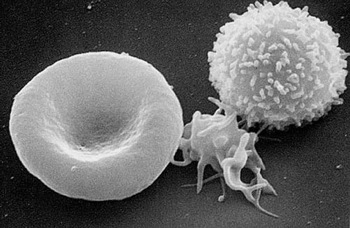
Blood
last authored:
last reviewed:
Introduction

red blood cell, platelet, and T cell, courtesy of NCI
Blood is a specialized tissue consisting of plasma and several kinds of cells: erythrocytes (red blood cells), leukocytes (white blood cells), and thrombocytes (platelets).
Red blood cells constitute about 45% of whole blood, the plasma about 54.3%, and white cells about 0.7%.
In general, blood represents 8% of body weight. Men have 5-6 litres of blood, while women have 4-5 litres.
Plasma is a solution of water (~90%) with many dissolved contents. These include plasma proteins, nutrients, gases, electrolytes, and wastes such as urea and lactic acid.
Blood pH normally well-controlled between 7.35-7.45. Acid-base composition depends on levels of carbon dioxide and bicarbonate, controlled via homeostasis.
